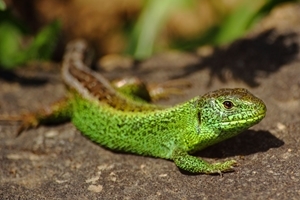Sand lizard
The rarest and most eye-catching emerald-green native lizard of the British Isles
 As a child I spent a lot of time in the New Forest. It was the childhood home of my grandmother where she grew up on the family farm, and most weekends when I stayed over, we would go on adventures looking for wildlife in the oak woodlands and on the open heathland. One highlight was going to the New Forest Reptile Centre, now run by the Forestry England. My grandfather used to pick me up so I could peer over the walled enclosures at our native species of reptiles.
As a child I spent a lot of time in the New Forest. It was the childhood home of my grandmother where she grew up on the family farm, and most weekends when I stayed over, we would go on adventures looking for wildlife in the oak woodlands and on the open heathland. One highlight was going to the New Forest Reptile Centre, now run by the Forestry England. My grandfather used to pick me up so I could peer over the walled enclosures at our native species of reptiles.
My favourite was the sand lizard (Lacerta agilis) and this month’s Species of the Month.
We have three species of native lizards here in Britain, the commonest of which is the viviparous or common lizard (Zootoca vivipara – scientific name ‘vivipara’ means ‘live birth’); the others are the sand lizard and the legless lizard, the slowworm (Anguis fragilis). Did you know, the sand lizard is the only species of lizard in Britain that lays eggs!
The sand lizard is the largest lizard with legs, with an average lifespan of up to 20 years, growing 20cm in length with the tail accounting for about half of this length, and can be called ‘robust’ in appearance. It weighs 15g and favours sandy heathland habitats and sand dunes, with scrub cover, and can be spotted basking on bare patches of sand.
Out of the breeding season, both sexes have varied brown patterns down the back with two strong dorsal stripes, and the differences are subtle. However, the males are stockier in appearance, with a heavy-set jaw and larger heads with a series of black crazing marks along the flanks compared to the females, which are a sandy-brown colour, with rows of regular larger ocelli dark blotches along the flanks.
In spring, the difference between the sexes is clear. The males can be readily seen on mounds, defending their territory, and have developed into a bright vivid emerald-green colour as they get ready to mate during the breeding season in late April and May. They are quite eye-catching and make them easy to spot and identify as a male! Sand lizards reach sexual maturity in the wild between three and seven years of age.
Sand lizards are a specialist of heathland and dune habitats and one of the UK’s rarest reptiles, due to habitat loss confining this species to only a few naturally occurring protected heathland sites in Surrey, Dorset, Hampshire and the protected Merseyside dunes systems, which I have been to as my reptile-mad degree lecturer, Andy Quayle, once detoured to on the way back from a Scotland field trip to chance a sighting. The sand lizard requires both mature sunny habitats and open undisturbed sand to lay their eggs, and they can have quite limited distribution even within the protected sites, as they are dependent on well-managed heathland or sand dune habitats, where it occupies mature vegetation that provides good cover.
Sand lizards feed on spiders, grasshoppers and crickets, and dig burrows for shelter, both for night-time refuge and for hibernation. The burrows can be as deep as one metre but tend to be small in diameter. They dig their burrows in sandy soil, with the entrance usually hidden in the undergrowth and turning sharply after just a few centimetres so that the lizard is concealed when inside. Sometimes, sand lizards dig their own hibernation burrow within the walls of a rabbit warren.
Sand lizards emerge from hibernation from late March to April and the female lay eggs buried in the sand in late May-June. The eggs are left buried in sand exposed to the sun, which helps to keep them warm, and they hatch between late August and September.
During the time of burying eggs, the females are at higher risk of predation, because they are preoccupied when digging and chasing off competition for the best sites. The main predators of the sand lizard are birds of prey (particularly kestrels), the rare smooth snake (Coronella austriaca) – so Britain’s rarest reptile predates Britain’s second rarest reptile – and pheasants, with added mammalian threats coming in the form of foxes, mustelids (badgers and weasels) and, where sand lizard habitat borders human habitation, a major predator is the domestic cat.
It does sound all doom and gloom, but there is a glimmer of hope. With thanks to fantastic conservation efforts and a successful reintroduction programme led by Amphibian and Reptile Conservation (ARC), sand lizards have now been re-established at many other sites to restore its historic range. These protected dune sites are in north and west Wales, Kent, West Sussex, Devon and Cornwall. However, work needs to continue to manage and extend their range.
Keep an eye out for a darting emerald while you are on a dune or heathland this summer!
Megan Lock
Advisory
Image credit: Christoph Caina